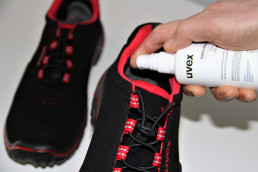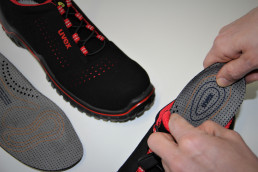We’re all familiar with the problem of smelly shoes. Shoe odour affects us in all areas of our lives – from the everyday shoes we wear to do the shopping, the trainers we go jogging in, the high heels we wear when we’re out for the evening or the work shoes we need for an 8-hour shift. But where does this unpleasant odour actually come from and what can you do to prevent it? In this blog article, we explain everything.
Where does shoe odour come from?
Every shoe has its own odour once produced – this comes from the various materials from which the shoe is made. A strong odour may develop as soon as these materials come into contact with adhesives. Particularly when stored in a shoebox for longer periods of time, the odour of your shoes becomes stronger, but normally vanishes after a day or two out of the box.
That’s why at uvex safety we make sure, right from the selection of the materials, that our safety and occupational shoes are produced to be as odour-neutral as possible. We specifically avoid the unnecessary use of adhesives, keeping this to the absolute minimum. For many of our work shoes, our direct soling process allows us to completely do away with the need for adhesive when attaching the outsole. During this process, the polyurethane outsole is foamed directly onto the outer shoe material – making uvex safety and occupational shoes largely odourless.

However, most shoe odour only develops during use. When worn, every shoe has to absorb large quantities of foot sweat: during an 8- to 10-hour day alone, the human foot can produce up to 200 ml of sweat. The work shoe must first handle this amount of liquid – some is converted to steam and released through the outer shoe material. Some is retained in the individual components of the shoe – in the lining, the outer shoe material, the insole and the footbed. In addition, shoes don’t just have to deal with foot sweat, they are also exposed to many other environmental factors, liquids and dirt in the workplace or during everyday use. Once the shoe becomes sweaty, the warm and humid microclimate inside the shoe creates the perfect conditions for the growth of bacteria and fungi. Unpleasant shoe odour is the result of bacteria breaking down the foot sweat. But how do you get rid of this odour from your shoes? Can you actually prevent your shoes from smelling in the first place?
How can I prevent unpleasant shoe odour?
Are you sick of being embarrassed when you take your shoes off in the changing room?
By doing the following, you can prevent the build-up of unpleasant odours in your work shoes or eliminate existing odours:
- Choose work shoes that offer the necessary ventilation for your workplace.
- Give your shoes enough time to dry out completely between uses.
- Always wear your safety and occupational shoes with socks or stockings with good moisture wicking properties. Mixed fabric socks that contain new wool are the best option.
- Change your socks every day.
- Use two pairs of shoes in rotation or a second pair of original uvex insoles.
- Wash the insoles by hand at 30°C if very dirty.
- Replace your insoles regularly.
- Use shoe deodorisers or disinfectants, such as the uvex nano-shoe add-in, regularly.

Correctly caring for and cleaning your work shoes also prevents the build-up of shoe odour and helps them last longer. Read our blog article to find out how to correctly clean and care for your safety and occupational shoes.
Declare war on shoe odour now and keep your shoes odour-free at all times. Use the comments to tell us about your experiences with shoe odour or to give us your tips on how to fight it.